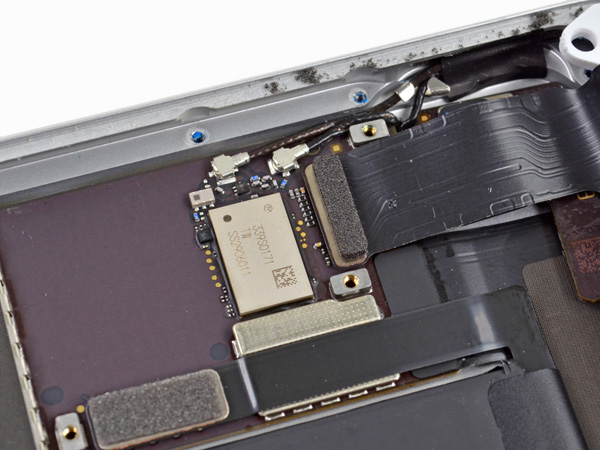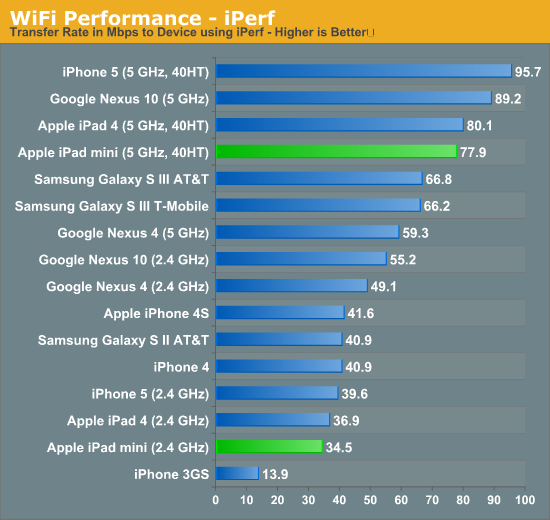iPad mini Review
by Anand Lal Shimpi & Vivek Gowri on November 20, 2012 6:10 PM ESTWiFi Performance
The mini uses the same Broadcom BCM4334 WiFi controller as the iPhone 5. The WiFi stack supports dual-band 802.11n as well as fallback to 802.11b/g.

iPad mini WiFi controller - image courtesy iFixit
Since the mini uses the same WiFi stack as the iPhone 5, you get support for 40MHz channels on 5GHz networks (20MHz on 2.4GHz). The maximum PHY rate supported is 72Mbps on 2.4GHz and a whopping 150Mbps on 5GHz.

In terms of actual performance, this works out to be a maximum of just under 100Mbps on a 5GHz network with 40MHz channels. In practice I wasn't able to get higher than 91Mbps, although Brian managed a very nice 95.7Mbps on the iPhone 5 in his tests. On average I pulled nearly 78Mbps on the mini on a 5GHz network. Move down to 2.4GHz and performance is cut roughly in half (peak performance is around 41Mbps).

I didn't have any issues with WiFi reception or performance in my testing of the iPad mini. The only complaint I really have at this point is I would love to see more intelligence when it comes to switching between multiple known APs of varying signal strengths. This is a problem on pretty much all devices I play with, they tend to want to stay on an existing network even if its performance drops significantly and there is another, better performing network that could be jumped to. I feel like some more intelligence in this department (testing nearby networks, looking for an ability to seamlessly switch and get better performance) would help mitigate a lot of the inevitable "hey my WiFi is broken" complaints we often see with a move to a new WiFi stack. You could also argue that we just need better designed WiFi deployments.










140 Comments
View All Comments
MadMan007 - Tuesday, November 20, 2012 - link
Here's another display-related thing to fix: the charts for Brightness (black and white) and contrast don't include the Nexus 7 for some bizarre reason..hmm...but the later charts on the same page 4 do.Anand Lal Shimpi - Tuesday, November 20, 2012 - link
Fixed, thank you :)Take care,
Anand
ksherman - Tuesday, November 20, 2012 - link
While I understand where you're coming from, the reason the Nexus is zoomed in is because the Nexus "fakes" it's resolution in the web browser to about 603 so that responsive web pages render elements larger so they're easier to use on the Nexus 7. So the side by side photo is simply comparing the default view on load.In fact, this is actually somewhat of a negative for the iPad Mini on responsive sites because it means it's rendering pages designed for a much larger display.
Source: http://www.lukew.com/ff/entry.asp?1663
MadMan007 - Wednesday, November 21, 2012 - link
Now this would be something interesting to investigate and inform readers about. I didn't know about different devices presenting different resolutions and am not sure what the differences really mean.Galatian - Tuesday, November 20, 2012 - link
As a medical student I fast pretty fast in preordering the cellular white iPad mini here in Germany. It is the perfect size to fit into a white coats pocket. I will read a lot of books on it, so it was a hard decision between this and the 4th Gen iPad. But size does matter and eventually Retina will come to the mini line. For right now I just have to live with the resolution.Granseth - Tuesday, November 20, 2012 - link
This is a big issue for me with the Ipad 2, and it will be the same with Ipad mini. When I try to use the Ipad2 as a productive device I often lose information I write because the webpages and apps has to reload when the device gets out of memory and have to free something to load the next app/webpage. And this has become much worse as the Ipad has aged, so it's terrible that they are selling a new device with only 512MB of RAM.But hopefully people will use this smaller device as a consumption device, and not a productivity device.
ratte - Tuesday, November 20, 2012 - link
Excellent review as always, balanced and informative.It's a pity that Apple can't easily go to an intermediate resolution like 1600 x 1200, like Android can, but is stuck with the rezdoubling. For me the mini would have felt more futureproof if they had used an A6 with 1Gb memory. but then this is Apple....
MadMan007 - Tuesday, November 20, 2012 - link
Yeah, they need something obvious but AWESOME to make sure everyone buys a new one next year.Gaugamela - Tuesday, November 20, 2012 - link
Now it's easy to understand why Apple wanted to ban the Galaxy Tab 7.7. The iPad Mini is a rip-off of it. With a much worse display since the GT7.7 had a Super Amoled + display of superior resolution.Samsung was a year ahead of Apple and it still holds up great, if Samsung updated it to Jelly Bean.
I would like to see a new Galaxy Tab 7.7.
And the display is a disapointment. It makes it a no buy device instantly, it's 130$ more expensive than the Nexus 7 and offers a worse display. Anyone that picks the Mini should only do it by the form factor or preference by iOS.
ltcommanderdata - Tuesday, November 20, 2012 - link
The form factor is why I'm considering the iPad Mini over the Nexus 7. It has great build quality, is thinner, lighter, yet has battery life that is similar or better and has a screen that's a third larger. The Nexus 7's advantage in screen resolution in itself is not as important for me because the screen is smaller so showing more tiny content isn't useful. The lower pixel density is a concern for clarity. The CPU may be weaker, but the GPU is stronger which given good GPU acceleration for UI responsiveness is a reasonable exchange. $130 more maybe worth it if the better form factor makes the device more useable so that it sees more use.